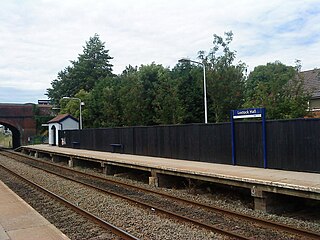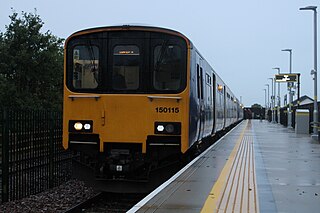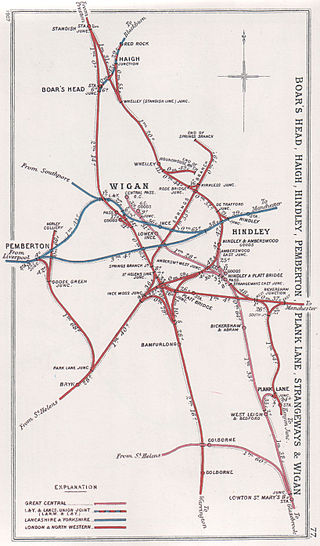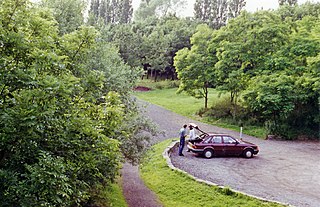
The Lancashire and Yorkshire Railway (L&YR) was a major British railway company before the 1923 Grouping. It was incorporated in 1847 from an amalgamation of several existing railways. It was the third-largest railway system based in northern England.

Liverpool Exchange railway station was a railway station located in the city centre of Liverpool, England. Of the four terminal stations in Liverpool's city centre, Exchange station was the only station not accessed via a tunnel.

The Liverpool and Bury Railway was formed in 1845 and opened on 28 November 1848. The line ran from Liverpool Exchange first using a joint line with Liverpool, Ormskirk and Preston Railway before branching off to proceed via Kirkby then Wigan and Bolton to Bury.

The St Helens and Runcorn Gap Railway was an early railway line owned by a company of the same name in Lancashire, England, which opened in 1833. It was later known as St Helens Railway. It ran originally from the town of St Helens to the area which would later develop into the town of Widnes. Branches were opened to Garston, Warrington and Rainford. The company was taken over by the London and North Western Railway in 1864. The line from St Helens to Widnes and the branch to Rainford are now closed, the latter terminating at the Pilkington Glass' Cowley Hill works siding near Gerard's Bridge, but part of the lines to Garston and to Warrington are still in operation.

Lostock Hall railway station is a railway station serving the village of Lostock Hall in the South Ribble borough of Lancashire, England. It is on the East Lancashire Line and is managed by Northern, who also provide all passenger trains serving it.

Cherry Tree railway station serves Cherry Tree in the Blackburn with Darwen borough of Lancashire, England. The station is 1.9 miles (3 km) southwest of Blackburn railway station. It is managed by Northern, who also provide all the passenger services calling there.

Wigan Wallgate railway station is one of two railway stations serving the town centre of Wigan in Greater Manchester, England. The station serves two routes, the Manchester-Southport Line and the Manchester-Kirkby Line. It is 16 miles north-west of Manchester Victoria. The station is managed by Northern Trains, who operate all trains serving it.

Garswood railway station serves the village of Garswood in the Metropolitan Borough of St Helens, Merseyside, England. It is situated on the electrified Merseytravel Liverpool to Wigan City Line, 15 miles (24 km) northeast of Liverpool Lime Street. The station, and all trains serving it, are operated by Northern Trains, however the station is branded Merseyrail using Merseyrail ticketing.

Heapey is a village and civil parish of the Borough of Chorley, in Lancashire, England. The village is two miles from Chorley and on the western fringe of the West Pennine Moors. In 2001 the population was 955, increasing to 1,001 at the 2011 census.

The Kirkby Branch Line is a branch railway line from Wigan to Headbolt Lane. The line's original route was from Liverpool to Bury and later the most northern of the Liverpool to Manchester lines. The line was split at Kirkby in 1977 with the western section forming a high frequency branch of the electrified Merseyrail Northern Line, also referred to as the Kirkby branch line. The Kirkby branch to Wigan remained a low frequency diesel operated service by Northern Trains from Headbolt Lane to Manchester.

Hindley South railway station served the communities of Hindley and Platt Bridge, south-east of Wigan, England.
Feniscowles railway station was a railway station that served the village of Feniscowles, in Blackburn with Darwen in Lancashire, England.
White Bear railway station, on Station Road, Adlington, Lancashire, England, was on the Lancashire Union Railway line between St Helens and Blackburn. The station was named in some timetables as White Bear (Adlington) or White Bear for Adlington.

The railway system in Wigan started development in the 19th century during the Industrial Revolution. The first railway built in the town was the Wigan Branch Railway which was opened on 3 September 1832 to serve the many collieries in the area; this was a branch line of the Liverpool and Manchester Railway, the first inter-city railway. By the turn of the 20th century, Wigan had numerous railway stations widely available across the borough, used by both freight and passengers. Many of the lines were originally built for freight which were later converted, as the owners saw the profitability of allowing passengers, to carry passenger trains.

Culcheth railway station served the village of Culcheth, Lancashire, England. It was west of the bridge where Wigshaw Lane crossed the railway.

Boar's Head railway station served the southern part of the village of Standish.

Whelley railway station was in Whelley, Wigan on the Whelley Loop section of the Lancashire Union Railway. The station was situated where the B5238 bridged the line.

Amberswood (Hindley) railway station was in Hindley, Wigan on the Whelley Loop section of the Lancashire Union Railway. The station was situated where the A577 passed under the line.

St Helens Central (GCR) railway station served the town of St Helens, England with passenger traffic between 1900 and 1952 and goods traffic until 1965. It was the terminus of a branch line from Lowton St Mary's.
Lowton St Mary's railway station served the scattered community of Lowton, then in Lancashire, now in Greater Manchester, England. It was situated immediately south of the A572 bridge over the tracks.















